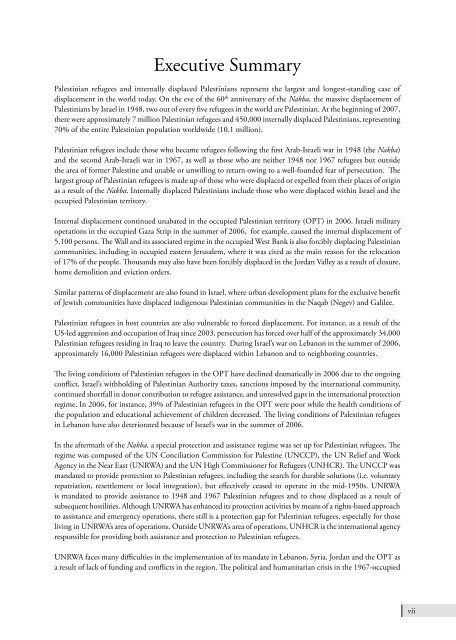BADIL Resource Center for Palestinian Residency and Refugee
BADIL Resource Center for Palestinian Residency and Refugee
BADIL Resource Center for Palestinian Residency and Refugee
Create successful ePaper yourself
Turn your PDF publications into a flip-book with our unique Google optimized e-Paper software.
Executive Summary<br />
<strong>Palestinian</strong> refugees <strong>and</strong> internally displaced <strong>Palestinian</strong>s represent the largest <strong>and</strong> longest-st<strong>and</strong>ing case of<br />
displacement in the world today. On the eve of the 60 th anniversary of the Nakba, the massive displacement of<br />
<strong>Palestinian</strong>s by Israel in 1948, two out of every five refugees in the world are <strong>Palestinian</strong>. At the beginning of 2007,<br />
there were approximately 7 million <strong>Palestinian</strong> refugees <strong>and</strong> 450,000 internally displaced <strong>Palestinian</strong>s, representing<br />
70% of the entire <strong>Palestinian</strong> population worldwide (10.1 million).<br />
<strong>Palestinian</strong> refugees include those who became refugees following the first Arab-Israeli war in 1948 (the Nakba)<br />
<strong>and</strong> the second Arab-Israeli war in 1967, as well as those who are neither 1948 nor 1967 refugees but outside<br />
the area of <strong>for</strong>mer Palestine <strong>and</strong> unable or unwilling to return owing to a well-founded fear of persecution. The<br />
largest group of <strong>Palestinian</strong> refugees is made up of those who were displaced or expelled from their places of origin<br />
as a result of the Nakba. Internally displaced <strong>Palestinian</strong>s include those who were displaced within Israel <strong>and</strong> the<br />
occupied <strong>Palestinian</strong> territory.<br />
Internal displacement continued unabated in the occupied <strong>Palestinian</strong> territory (OPT) in 2006. Israeli military<br />
operations in the occupied Gaza Strip in the summer of 2006, <strong>for</strong> example, caused the internal displacement of<br />
5,100 persons. The Wall <strong>and</strong> its associated regime in the occupied West Bank is also <strong>for</strong>cibly displacing <strong>Palestinian</strong><br />
communities, including in occupied eastern Jerusalem, where it was cited as the main reason <strong>for</strong> the relocation<br />
of 17% of the people. Thous<strong>and</strong>s may also have been <strong>for</strong>cibly displaced in the Jordan Valley as a result of closure,<br />
home demolition <strong>and</strong> eviction orders.<br />
Similar patterns of displacement are also found in Israel, where urban development plans <strong>for</strong> the exclusive benefit<br />
of Jewish communities have displaced indigenous <strong>Palestinian</strong> communities in the Naqab (Negev) <strong>and</strong> Galilee.<br />
<strong>Palestinian</strong> refugees in host countries are also vulnerable to <strong>for</strong>ced displacement. For instance, as a result of the<br />
US-led aggression <strong>and</strong> occupation of Iraq since 2003, persecution has <strong>for</strong>ced over half of the approximately 34,000<br />
<strong>Palestinian</strong> refugees residing in Iraq to leave the country. During Israel’s war on Lebanon in the summer of 2006,<br />
approximately 16,000 <strong>Palestinian</strong> refugees were displaced within Lebanon <strong>and</strong> to neighboring countries.<br />
The living conditions of <strong>Palestinian</strong> refugees in the OPT have declined dramatically in 2006 due to the ongoing<br />
conflict, Israel’s withholding of <strong>Palestinian</strong> Authority taxes, sanctions imposed by the international community,<br />
continued shortfall in donor contribution to refugee assistance, <strong>and</strong> unresolved gaps in the international protection<br />
regime. In 2006, <strong>for</strong> instance, 39% of <strong>Palestinian</strong> refugees in the OPT were poor while the health conditions of<br />
the population <strong>and</strong> educational achievement of children decreased. The living conditions of <strong>Palestinian</strong> refugees<br />
in Lebanon have also deteriorated because of Israel’s war in the summer of 2006.<br />
In the aftermath of the Nakba, a special protection <strong>and</strong> assistance regime was set up <strong>for</strong> <strong>Palestinian</strong> refugees. The<br />
regime was composed of the UN Conciliation Commission <strong>for</strong> Palestine (UNCCP), the UN Relief <strong>and</strong> Work<br />
Agency in the Near East (UNRWA) <strong>and</strong> the UN High Commissioner <strong>for</strong> <strong>Refugee</strong>s (UNHCR). The UNCCP was<br />
m<strong>and</strong>ated to provide protection to <strong>Palestinian</strong> refugees, including the search <strong>for</strong> durable solutions (i.e. voluntary<br />
repatriation, resettlement or local integration), but effectively ceased to operate in the mid-1950s. UNRWA<br />
is m<strong>and</strong>ated to provide assistance to 1948 <strong>and</strong> 1967 <strong>Palestinian</strong> refugees <strong>and</strong> to those displaced as a result of<br />
subsequent hostilities. Although UNRWA has enhanced its protection activities by means of a rights-based approach<br />
to assistance <strong>and</strong> emergency operations, there still is a protection gap <strong>for</strong> <strong>Palestinian</strong> refugees, especially <strong>for</strong> those<br />
living in UNRWA’s area of operations. Outside UNRWA’s area of operations, UNHCR is the international agency<br />
responsible <strong>for</strong> providing both assistance <strong>and</strong> protection to <strong>Palestinian</strong> refugees.<br />
UNRWA faces many difficulties in the implementation of its m<strong>and</strong>ate in Lebanon, Syria, Jordan <strong>and</strong> the OPT as<br />
a result of lack of funding <strong>and</strong> conflicts in the region. The political <strong>and</strong> humanitarian crisis in the 1967-occupied<br />
vii

















